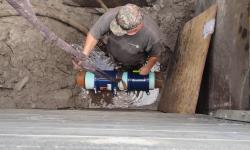 The Client
The Client
The Water Department for the City of Haines City, Florida serves 20,000 customers, and oversees and maintains:
- 89 miles of water mains ranging from 2 to 30 inches
- 7 miles of reclaimed water
- 40 miles of force mains, and
- 51 miles of gravity sewer mains with 850 manholes
Haines City utility foreman James Coker has worked for the City of Haines City since 2001. He and his team provide 24-hour support for repairs, and also support surrounding municipalities when required.
The Situation
In 2012, a cable company bore into the ground within a residential area in Haines City, and hit a 10-inch gravity sewer pipe made of clay causing it to break. When Coker and his team arrived, they started by contracting out the excavation of the pipe which was 12 feet deep. The break was significant enough that the damaged pipe had to be cut out and replaced with polyvinyl chloride (PVC) pipe joined to the clay pipe with couplings at each end.
The Challenge
Coker faced two challenges in ensuring the connection would be strong, secure and durable over the long term.
1. The connection needed to be flexible.
The ground surrounding the pipe was often wet and muddy meaning the ground would often shift. The connections between the PVC and clay pipe would have to be flexible enough to absorb these ground shifts, otherwise the connection would weaken and break over time.
2. The connection needed to allow for sewage to flow freely.
Rubber coupling hose clamps could be used to allow for flexibility given the shifting ground and accommodate the outside diameters (OD) of the PVC and clay pipes. The problem with this kind of connection is that shifts in the ground could cause the coupling to bend, which would obstruct sewage flow and catch debris.
Coker sought a coupling with the flexibility to accommodate shifting ground, yet would be rigid enough to allow sewage to flow through the pipe easily.
The Solution
Coker used two HYMAX couplings to connect the PVC pipe on each end to the clay pipe.
 There were two fundamental advantages that the HYMAX presented for this repair:
There were two fundamental advantages that the HYMAX presented for this repair:
1. HYMAX’s deflection capability
The HYMAX allows for each connecting pipe end to flex four degrees, enabling continuous dynamic angular deflection. Simultaneously, the connection is strong and durable, allowing for sewage to flow easily, and still flexible enough to adapt to ground shifts.
2. HYMAX’s wide OD range
The HYMAX easily allowed for a tight seal to be achieved in spite of the differing materials of the connecting pipes (PVC and clay) and the OD difference between the two kinds of piping. The HYMAX’s two gaskets made it possible for a tight fit to be made despite these differences.
Once the damaged clay pipe was removed, a piece of PVC piping was measured and cut to size. Coker’s crew loosened the HYMAX’s 2-bolt enclosures and slid the two HYMAX couplings onto each end of the pipe (see photo left). Once the couplings were attached, the pipe was lowered down into the crevice where the repair was made.
Once in place, the HYMAXs were slid into place to connect the PVC pipe with the clay pipe in the ground (see photo right). Space was measured between the PVC and the clay pipe within the coupling as the deflection abilities of the coupling be limited if they touched within the HYMAX. At this point, the crew tightened the two top-facing bolts on each HYMAX coupling to complete the repair.
Conclusions
The HYMAX offered three advantages in repairing the sewer pipe.
1. Deflection Capabilities While Allowing a Clear Flow Path
The HYMAX provided a strong connection that allowed for both flexibility to handle ground shifts while being firm enough to provide a clear flow path.
2. Accommodate a wide range of ODs and piping materials
The HYMAX allowed for a wide range of ODs and pipes of differing materials, making it possible to use within a wide range of circumstances.
3. Ease of installation
The two-bolt top facing nature of the HYMAX closure made installation quick and simple.

